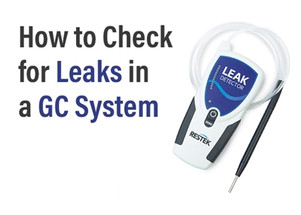Posted by Chrom Tech on 14th Oct 2025
How to Check for Leaks in a GC System
Maintaining a leak-free GC or GC/MS system is essential for producing reliable, reproducible, and accurate chromatographic results. Even minor gas leaks can compromise sensitivity, contaminate samples, or cause column damage—all of which affect performance and data integrity. Fortunately, small leaks can be quickly identified and prevented from escalating into major problems by using an electronic leak detector to pinpoint their location with precision.
Symptoms of a Leak in the GC System
Gas leaks within a gas chromatograph can present themselves in several ways. Large leaks typically prevent the system from reaching a ready state and may trigger an electronic pressure control (EPC) safety shutdown. Common causes include:
- Improper column installation or incorrect inlet/detector connection
- Damaged columns, ferrules, or fittings
- Loose or broken tubing connections
- Septa with cored punctures or degradation
- Partial tubing blockages
Smaller leaks, though less obvious, can still have significant effects. Symptoms include:
- Fluctuating or unstable pressure readings
- Irregular retention times or poor reproducibility
- Elevated baseline noise or column bleed
Routine monitoring of system performance—especially during startup and shutdown sequences—can help identify leaks early and prevent costly downtime.
Where to Check for GC Gas Leaks
Whether or not you’re experiencing issues, regular leak inspection should be part of every lab’s preventive maintenance schedule. When performing a check, increase the GC system pressure while the instrument is cool—this exaggerates small leaks, making them easier to detect. Below are ten key points to inspect during a GC leak check:
- Gas supply: Check the regulator and fittings, especially after cylinder changes.
- Gas filter connections: Inspect after each filter replacement.
- Shutoff valves: Older valves can develop microleaks over time.
- EPC (Electronic Pressure Control) connection: A critical area—since all carrier gases enter here, leaks can affect the entire system.
- Split vent trap: Often overlooked but prone to small leaks.
- Septum or septum nut: Frequent source of leaks due to wear from repeated injections.
- Weldment and weldment lines: Check for cracks or over-tightening damage.
- Reducing nuts: Can loosen due to thermal cycling.
- Inlet and detector column nuts: Ensure ferrules are intact and nuts properly torqued.
- Column connectors: Regularly inspect all connectors for wear and re-tighten as needed.
Regular leak checks not only safeguard analytical performance but also extend the lifespan of critical system components such as columns, detectors, and seals.
Advantages of the Restek Electronic Leak Detector
Traditional methods like “snoop” or soap bubble tests are outdated and unreliable for modern chromatography systems. The Restek Electronic Leak Detector offers a faster, safer, and more precise solution for leak detection across gas lines and fittings. Key benefits include:
- Real-time detection: Instantly identifies even the smallest leaks with audible and visual alerts.
- Rechargeable design: Can be operated while charging when needed—ideal for busy lab environments.
- Compact and portable: Lightweight construction makes it easy to maneuver around instrument bays.
- Protects system investment: Prevents contamination, premature column failure, and unnecessary downtime.
Regular use of the Restek Leak Detector helps maintain your system’s optimal performance, ensuring accurate and repeatable results in every GC or GC/MS analysis.
Chrom Tech Support and Resources
As an authorized distributor of Restek and other leading chromatography brands, Chrom Tech provides expert product guidance and rapid shipping on essential GC maintenance tools. If you have questions about the Restek Electronic Leak Detector or need assistance identifying replacement parts or consumables, contact our team via live chat, phone, or email. Our chromatography specialists are ready to help keep your lab running efficiently.
Frequently Asked Questions About GC Leak Detection
How often should I check my GC system for leaks?
Perform leak checks at least weekly—or immediately after maintenance, column installation, or gas line changes. Regular inspection helps catch small leaks before they affect system performance.
Can I use the Restek Electronic Leak Detector while charging?
Yes. The Restek detector can be operated while charging, though this is not recommended as a regular practice. Always fully charge the device before extended use for best performance.
What are common signs of a GC gas leak?
Unstable pressure, inconsistent retention times, elevated baseline noise, or frequent EPC shutdowns are common indicators. If these occur, use an electronic leak detector to confirm and resolve the issue promptly.
Does Chrom Tech stock Restek leak detectors?
Yes. Chrom Tech stocks the Restek Electronic Leak Detector and other GC maintenance accessories for fast delivery and competitive pricing.

